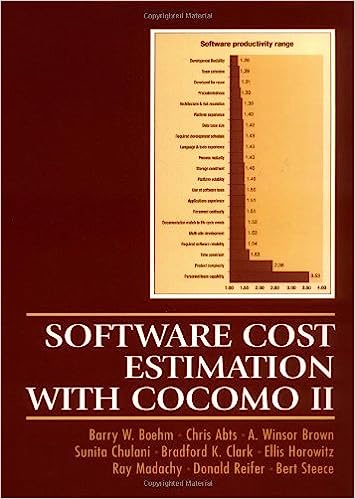COCOMO II
Overview
COnstructive COst MOdel II (COCOMO® II) is a model that allows one to estimate the cost, effort, and schedule when planning a new software development activity. COCOMO II is the latest major extension to the original COCOMO model published in 1981 (now referred to as COCOMO 81). It consists of three submodels, each one offering increased fidelity the further along one is in the project planning and design process. Listed in increasing fidelity, these submodels are called:
- Applications Composition model
- Early Design model
- Post-architecture model
COCOMO II is useful in the following situations:
- Making investment or other financial decisions involving a software development effort
- Setting project budgets and schedules as a basis for planning and control
- Deciding on or negotiating tradeoffs among software cost, schedule, functionality, performance or quality factors
- Making software cost and schedule risk management decisions
- Deciding which parts of a software system to develop, reuse, lease, or purchase
- Making legacy software inventory decisions: what parts to modify, phase out, outsource, etc
- Setting mixed investment strategies to improve organization’s software capability, via reuse, tools, process maturity, outsourcing, etc
- Deciding how to implement a process improvement strategy, such as that provided in the SEI CMM
The original COCOMO model, published by Dr. Barry Boehm in 1981, reflected the software development practices of the day. In the ensuing two decades, software development techniques changed dramatically. These changes included a move away from mainframe overnight batch processing to desktop-based immediate turnaround; a greatly increased emphasis on reusing existing software and building new systems using off-the-shelf software components; and spending as much effort to design and manage the software development process as was once spent creating the software product.
These changes and others began to make applying the COCOMO 81 model problematic. The solution to the problem was to reinvent the model for the 1990s. The result is COCOMO II, a revised cost estimation model reflecting the changes in professional software development practice that have come about since the 1970s. This new, improved COCOMO is now ready to assist professional software cost estimators for many years to come.
COCOMO III is a project underway to update COCOMO II.
Reference
Boehm, Barry W.; Abts, Chris; Brown, A. Winsor; ;Chulani, Sunita; Clark, Bradford K.; Horowitz, Ellis; Madachy, Ray; Reifer, Donald; Steece, Burt; Software Cost Estimation with COCOMO II, Prentice Hall, 2000.
This book explains the theory behind the model, while keeping a focus on the practical informational needs of the professional software cost estimator. This new book should be viewed as an updated supplement for Barry Boehm’s earlier text detailing the theory and application of COCOMO® 81. For the software professional, it serves quite well as a stand-alone resource. This book also contains information about the different parts of the COCOMO® Suite
